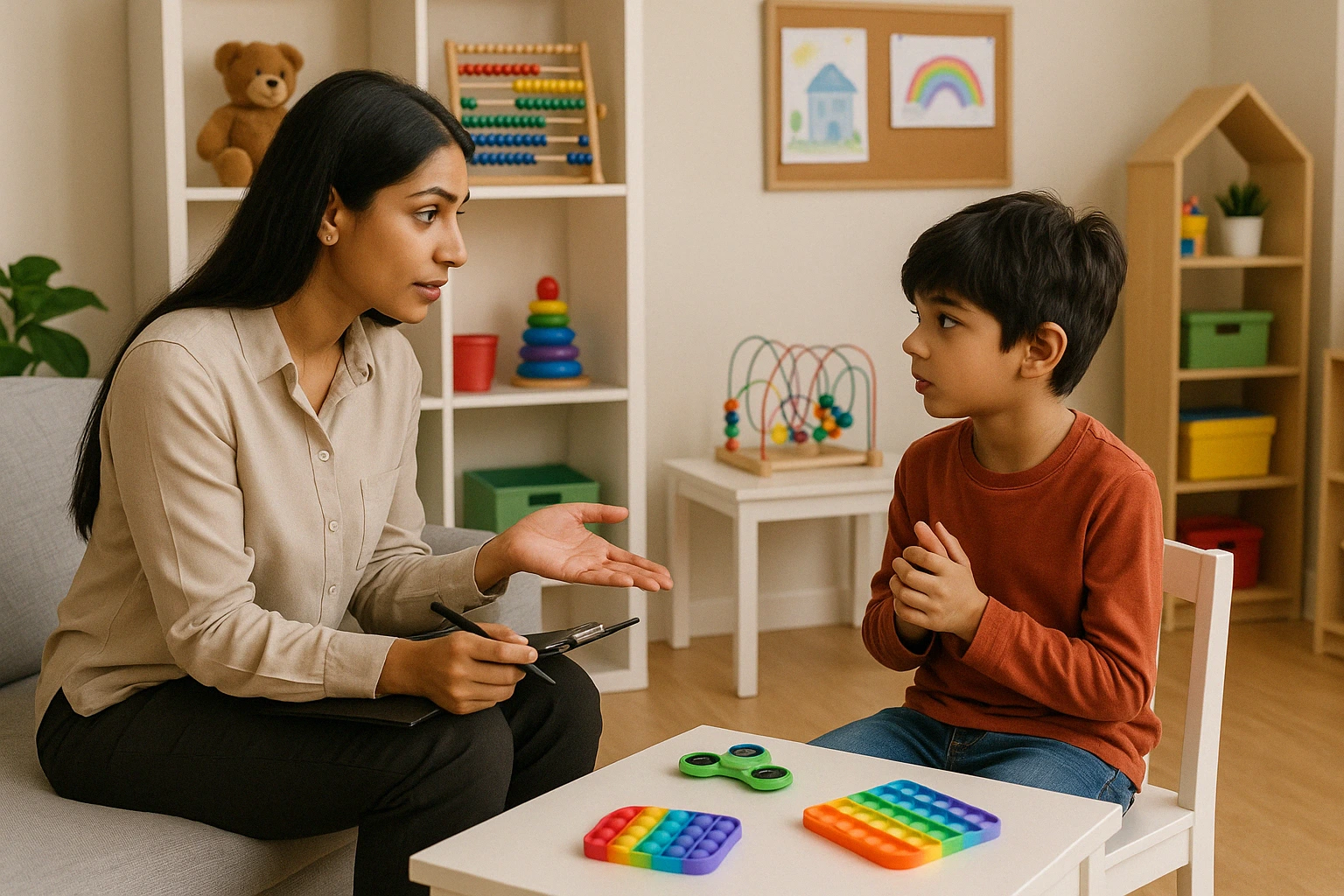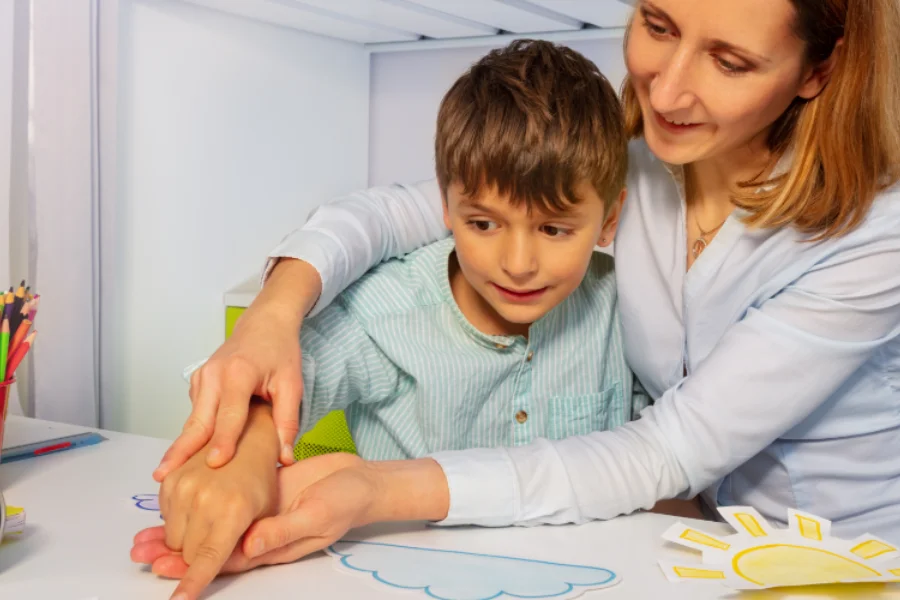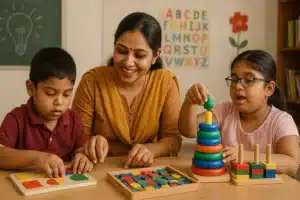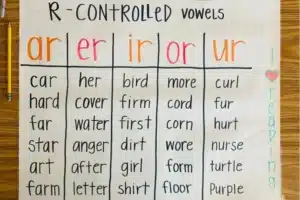
The most crucial step for providing any aid to children with attention deficit is to observe the child and note signs of struggle that hint towards a possibility of Attention deficit.
The signs of attention deficit can appear as issues with sustaining attention, forgetfulness, or impulsivity. The signs can show themselves in a school setting, at home, or even just within conversations. Although the experience of this condition will vary between individuals, recognising the signs of attention deficit early can lead to a possible resolution around getting the appropriate support and guidance. This blog focuses on the prominent symptoms, including the signs of attention deficit, to help understand its impact on your daily life.
10 Signs of ADHD?
signs of Attention Deficit Hyperactivity Disorder (ADHD) involves a chronic pattern of inattention, hyperactivity, and impulsivity that may interfere with functioning. Identifying it early is critical to proper support and intervention.
The 10 prime indicators of ADHD are listed below:
Always distracted
The slightest sounds or smallest diversion can distract ADHD individuals, making it very difficult for them to pay attention during long classes.
Habitual Absentmindedness
Adhd Individuals tend to forget deadlines, have a completely disorganised surrounding and often forget their belongings due to poor memory.
Meagre time management skills
ADHD individuals have deprived time management skills, due to which they always present unfinished and half-done assignments.
Physical Restlessness
Difficulty staying seated, excessive tapping, or constant movement are noticeable, particularly in structured environments.
Interruptive Behavior
Disruptive factors that are common include interrupting others as they speak, finishing others’ statements for them, or sharing an idea or thought before being called on.
Organisation Is Important
Repeated difficulties with the overall organisational system at home or school, including leaving messy desks with work materials scattered, and not turning in completed work.
Hasty actions
ADHD individuals act without thinking, due to which can lead to confusing situations and misunderstandings.
Incomplete work
ADHD individuals start any task with a lot of enthusiasm, but then completing it is a herculean task, as they easily lose focus.
Emotional Uncertainty
ADHD individuals might face rapid mood swings, extreme frustration due to irregular emotional regulation.
Listening Without Retention
ADHD individuals might give the impression that they are listening, but they wander in their own thoughts due to a poor attention span.
These signs of ADHD may vary in intensity and presentation across age groups. Early identification of the signs of ADHD can pave the way for timely interventions and improved quality of life.
For details of the SEN Course, Call / WhatsApp on +919321024137 / +919869866277.
To download the SEN Course brochure, Click Here!

How to get ADHD Symptoms Diagnosed?
Offering assistance to a child with ADHD requires effort and the adoption of the proper techniques at home and at school. Children with ADHD can, and need to, succeed academically, socially and emotionally, and fulfilling those needs requires a great degree of effort. Knowing a child’s needs and providing structure are invaluable. You will succeed in making a great impact.
Here’s how to begin the diagnostic process:
Consult with a Medical Provider
Begin with seeing a general physician or pediatrician who can refer you to a specialist such as a psychologist, psychiatrist, or neurologist.
Comprehensive Study of the Child
A thorough and detailed study of the child, highlighting his behaviour patterns, his way of responding and his reactions, must be studied from at least 2 to 3 settings where the child functions.
Use of Standardized Checklists
Professional therapists will have their standardized checklists and questionnaires that help them gain insights into the child’s symptoms, which they compare with what is expected for a person of that age group.
Input from Others
Information is acquired from Teachers, parents, or caregivers to look for any minute important details.
Ensure no other disorders are present.
Many times, different disorders might give the impression that the child possesses ADHD, so it is important to ensure that the child doesn’t possess any other conditions.
When the above steps are systematically undertaken, it helps to gain a proper diagnosis recognized by the well-known DSM-5. Acquiring a precise diagnosis at an early stage can help to minimize the grave challenges ADHD can bring along.
For details of the SEN Course, Call / WhatsApp on +919321024137 / +919869866277.
To download the SEN Course brochure, Click Here!

What is the Age Limit for ADHD?
The Symptoms of ADHD start appearing during their early years, especially when preschool begins and the child starts to function independently. The onset of strong ADHD symptoms starts at 6 and is at its peak at the age of 12.
Children: ADHD diagnoses are acquired between the ages of 6 and 12 when the child starts preschool, where the behaviour issues and attention span struggles begin.
Teens and Adults: When the symptoms of ADHD are passed off as traits of childish behaviour and laziness, it goes undetected, and a diagnosis can be received in adulthood.
Diagnostic Criteria: For any individual to be diagnosed as an ADHD individual the symptoms of ADHD should persist for a minimum of six months.
ADHD often continues into adulthood, even if symptoms change over time.
For details of the SEN Course, Call / WhatsApp on +919321024137 / +919869866277.
To download the SEN Course brochure, Click Here!

Source: amberhillpt
How to Help an ADHD Child?
Supporting a kid with ADHD requires a lot of patience, flexibility and support from the right methods in both home and school. With the right attitude and proper structure, children with ADHD can succeed academically as well as meet their social and emotional needs. When you take the time to know their needs and provide structure in their life, you can make a huge difference.
Vidhyanidhi Education Society (Govt. Regd.), a pioneer teacher training Institute, has initiated a top-notch Special Educator Course, empowering trainees to make a huge positive impact on the functioning of Children with special needs, enabling them to achieve their goals successfully.
Here are effective ways to help an ADHD child:
Follow a routine
Let the child follow a predictable routine where he is well-versed with the activities that are lined up for the day, especially meal times, study time and sleeping routine.
Divide the complicated process into simple steps
Complex problems can be broken down into simple, manageable steps. By step-by-step procedure helps to provide proper guidance and well-retained concepts for a long time.
Reward children
Always celebrate the smallest efforts and improvement of the child by giving him small rewards that encourage him to perform better, building motivation and self-confidence.
Set Clear and Simple Rules
Use concise language and visual reminders to outline expected behaviour. Avoid long explanations, which may be hard to follow.
Design a distraction-free space
Try and minimise distractions by creating a quiet learning space for the child and also set time limits for screens, especially mobiles, before sleeping.
Adequate movement-based activities
The child’s schedule must have adequate time for outdoor activity that helps to regulate their emotions and expend their energy productively. Including sports and dance as stress busters can be extremely helpful.
Promote social interaction skills
Train children in understanding facial cues and explain to them the importance of taking turns and paying attention, which will strengthen their social interaction skills.
Track their sleeping pattern and food intake
Keep a check on the type of food the child consumes, which can have an impact on their mood or energy levels. Encourage healthy sleeping patterns for a relaxed mind and a calm attitude.
Regular feedback
Maintaining regular communication with educators and other professionals helps to implement effective strategies in the classroom efficiently, which ensures better achievement of learning goals.
Consider Professional Support
Engaging in regular counselling, behaviour therapy helps to acquire tailored specific aid for the child.
Parents and teachers have to possess deep, detailed insights into the various aspects of ADHD to support the varied challenges of children with ADHD. Being a part of a Special Education Training program serves this purpose very well, educating them and training them about various strategies and tools to be used to manage the challenges for children with special needs.
Caregivers and teachers are able to understand the different issues that ADHD presents as well as appropriately use strategies based on research and proven outcomes with ADHD, because of the Special Educator Course offered by Vidhyanidhi Education Society (Govt. Regd.). This training in action and understanding is really useful in the home and school environments.
Join Vidhyanidhi Education Society’s SEN Course to shape futures as a Special Education Teacher!
For details of the SEN Course, Call / WhatsApp on +919321024137 / +919869866277.
To download the SEN Course brochure, Click Here!
FAQs
What are the signs of ADHD in children?
Acting without thinking, continuously out of place and always being distracted are some of the main signs of ADHD in children.
What are the consequences of not treating ADHD?
ADHD, when untreated, can have a snowball effect, causing plenty of other issues such as academic failures, poor self-image, interpersonal conflicts, and a myriad of other issues later in life.
How is ADHD viewed in children? Is it serious?
Learning, behaviour, and emotions can all be affected due to the developed condition. Things can be better in such a case with the right amount of training or support, such as the Vidhyanidhi Education Society’s Special Educators Course.



